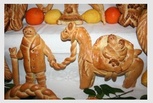An ancient history
Devotional, symbolic and votive breads have been recorded for almost as long as bread itself has been recorded.
Bread tablets from ancient Roman graves have been found in symbolic forms such as the key or the scissors and were intended to facilitate the escape from the underworld.
During the period of early Christianity breads were made in the shape of a cross, the dove of peace, the peacock indicating immortality, the fish which is the symbol of Christ, the lamb which indicates sacrifice and angels pointing to the resurrection or the the annunciation.
The preparation can also be an act of devotion. In many places (parts of Sicily, Belarus, Poland, among others) baking is accompanied by the sign of the cross and invocation. Both preparation and consumption can be considered auspicious and sometimes divine, with the aim of protecting the family and its livestock.
Devotional, symbolic and votive breads have been recorded for almost as long as bread itself has been recorded.
Bread tablets from ancient Roman graves have been found in symbolic forms such as the key or the scissors and were intended to facilitate the escape from the underworld.
During the period of early Christianity breads were made in the shape of a cross, the dove of peace, the peacock indicating immortality, the fish which is the symbol of Christ, the lamb which indicates sacrifice and angels pointing to the resurrection or the the annunciation.
The preparation can also be an act of devotion. In many places (parts of Sicily, Belarus, Poland, among others) baking is accompanied by the sign of the cross and invocation. Both preparation and consumption can be considered auspicious and sometimes divine, with the aim of protecting the family and its livestock.
Regions
Sicily
The origins of Italian bread as we know it today started with the arrival of a Muslim population in Marsala in the mid 800's. Skilled confectioners, they introduced the use of anise, lemon,dried chick peas, fritters and cinnamon into bread and sweet bread making. The word nougat comes from the Arabic 'nagals' (dried fruit.)
Sicily
The origins of Italian bread as we know it today started with the arrival of a Muslim population in Marsala in the mid 800's. Skilled confectioners, they introduced the use of anise, lemon,dried chick peas, fritters and cinnamon into bread and sweet bread making. The word nougat comes from the Arabic 'nagals' (dried fruit.)
Merging celebrations and rituals
Festivals have merged over time, celebrating more than one action or activity or deed. As part of this, a bread type that was a symbol of one thing and another bread that was a symbol of another thing often merged.
Celebrations of seasonal markers - the shortest or longest days of the year spring and autumn equinoxes - are the most common 'anchors' which are often combined with other, or more obscure, celebrations and rituals.
Festivals have merged over time, celebrating more than one action or activity or deed. As part of this, a bread type that was a symbol of one thing and another bread that was a symbol of another thing often merged.
Celebrations of seasonal markers - the shortest or longest days of the year spring and autumn equinoxes - are the most common 'anchors' which are often combined with other, or more obscure, celebrations and rituals.
Examples
St. Joseph's Day breads and altar (19 March) Sicily
St. Joseph's Day breads and altar (19 March) Sicily
- The celebration dates to the ancient cult of Demeter/Ceres in Greek/Roman mythology.
- By 1400, in Sicily, St Joseph Dinners commemorated a great famine in medieval Sicily, said to be relieved through the intervention of the saint.
- The holiday also eventually commemorated the Last Supper, and is celebrated close to the spring equinox, combining these two landmark events.
- St Joseph's altars contain not only bread but also a dazzling range of fruit, vegetables, lemons (a North African symbol of rebirth.) Bread and cakes are made in Christian symbols of rebirth (peacocks, lambs, etc.)
- The bread image of the holy family, with St Joseph leading a horse, often found at Christmas, is now part of these March 19 celebrations
